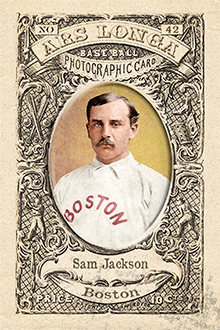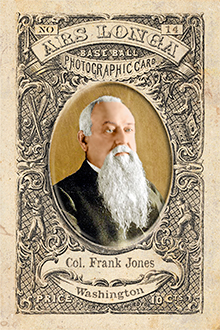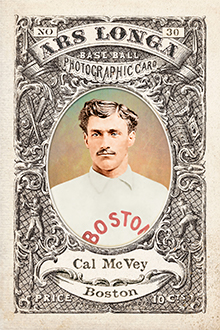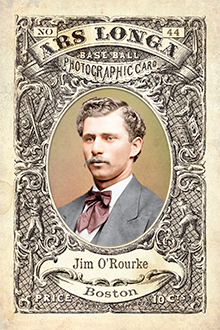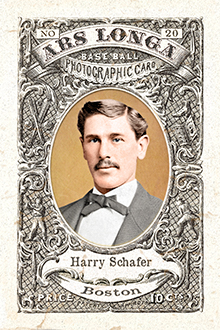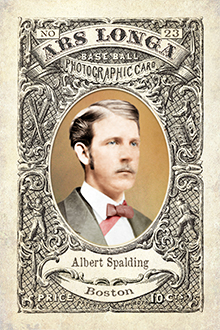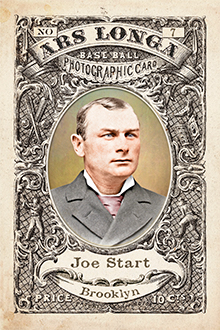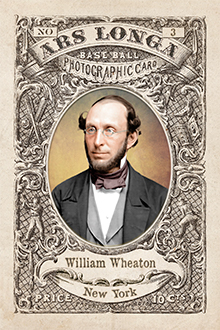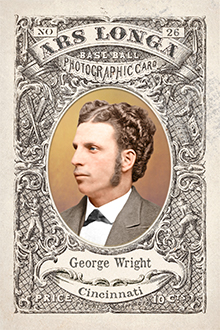- Series: Pioneer Portraits I: 1850-1874
- City: Boston
- Team: Red Stockings (NAPBBP)
- League: National Association (NAPBBP)
Samuel Jackson (1849-1930) was a native of Ripon, England who came to America and spent two years in his early 20s playing second base – for the Boston Red Stockings in 1871 and the Brooklyn Atlantics in 1872. The modest hitter compiled a .216 average with 11 RBI and 17 runs scored. Sam was unsuccessful in his only attempted stolen base. Afield, Jackson struggled as well, committing 19 errors in 100 chances.
- Jackson fared better in amateur ball and got noticed by the Cincinnati Chronicle for a great catch in left field for his Rochester Alerts in a contest with the vaunted Red Stockings on Sep 6, 1869
- Sam also played for the Flower Citys in Rochester in 1871 as the game was on the cusp of professionalism
- Series: Pioneer Portraits I: 1850-1874
- City: Washington, D.C.
- Team: Nationals
- League: National Association (NABBP)
Colonel Frank Jones, Cmdr of the 31st NY Regiment, former Excelsior of Brooklyn player, and then Treasury official, was pres. of the Washington Nationals in 1867. He had recruited top NY players such as George Wright to create a powerhouse. Their tour of the West, covered by “Father Henry” Chadwick, brought baseball to the national consciousness.
- The Nats’ thrashing of Harry Wright’s famed Red Stockings prompted him to build the 1st openly professional team
- Nats’ only loss on the tour was to Al Spalding’s Forest City club
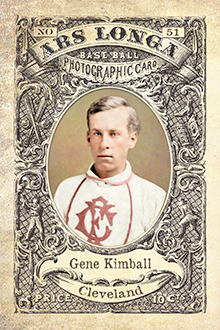
- Series: Pioneer Portraits I: 1850-1874
- City: Cleveland
- Team: Forest Citys (NAPBBP)
- League: National Association (NAPBBP)
Eugene Boynton Kimball (1850-1882) was an evanescent spirit on the early baseball scene. This ghost came to the (Cleveland) Forest Citys on May 4, 1871 and departed what was then major league play the following September. He had played in the early amateur National Association of Base Ball Players for the Alert of Rochester in 1869 and for the Cleveland club in 1870. That team was the first fully salaried team in Cleveland and was unaffiliated that season. In 1870 the Forest Citys (a designation adopted in recent years to distinguish the team from the pro club in Rockford, IL known as “Forest City”) were managed by Charlie Pabor. Charlie was dubbed “The Old Woman in the Red Cap,” giving him enduring status as the baseball figure with the most mysterious and alluring nickname of all time.
- Kimball’s debut in Rochester occurred on June 4, 1869 when the Alert hosted the powerhouse Cincinnati Red Stockings on their famed national tour. Gene played alongside other future major leaguers: John Glenn, Sam Jackson, John McKelvey and Ezra Sutton. The young amateurs held Harry Wright’s bombers to one of the closest margins of that undefeated season
- In his brief time with Cleveland, Gene managed a .191 average. He made 44 errors in 170 chances playing 2nd, 3rd, short and outfield in 29 games. It is reported that he achieved fair renown as a billiards player following his baseball career
- Series: Pioneer Portraits I: 1850-1874
- City: Boston
- Team: Red Stockings (NAPBBP)
- League: National Association (NAPBBP)
Andrew Jackson Leonard (1846-1903) played five years in the Nat’l Assoc of Base Ball Players in the amateur era and was signed by Harry Wright in 1869 to anchor left field for the Cincinnati Red Stockings, the original pro baseball team. In 1871 Leonard played for Nicholas Young on the Washington Olympics, the first year of the new professional league. In 1872 Leonard rejoined Wright in Boston as one of the elite players on this elite team. In two leagues, Leonard’s clubs won six pennants in seven years.
- Hit .299 lifetime over 9 seasons
- After four errors against Providence on July 3, 1880, Leonard was forced to retire due to failing eyesight

- Series: Pioneer Portraits I: 1850-1874
- City: Philadelphia
- Team: Athletics (NABBP)
- League: National Association (NAPBBP)
Fergus G. Malone (1844-1905) was a rare left-handed catcher, perhaps the first in major-league history (Bill Harbridge is another oft-cited contender for that title). Historians differ on what qualified then as a “major league,” but there is no doubt this Irishman was among the pioneers. He debuted with the Athletics in May, 1871 in the old National Association. A Civil War vet, Malone was a leader among his mates and was frequently tapped as “captain” or manager. He lasted in Philadelphia long enough for the new National League to form in 1876 while he was back with the Athletics. After a few seasons in the minors, Fergy got one last shot with the Union Association’s Philly Keystones in 1884 where a 19-year-old rookie named Jack Clements was starting out. Clements went on to be the most enduring and accomplished southpaw catcher in major league history.
- Fergy finished his time in pro ball managing Pennsylvania teams through 1888
- His batting average showed a downward arc probably related to the rigors of backstopping in the no-glove era: 1871 he hit .343, then .282, dropping steadily to .229 his last active season. Overall: .250
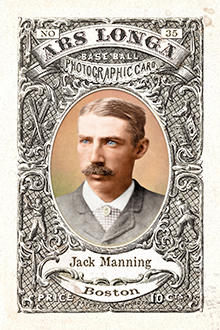
- Series: Pioneer Portraits I: 1850-1874
- City: Boston
- Team: Red Stockings (NAPBBP)
- League: National Association (NAPBBP)
John E. Manning (1853-1929) must have longed for his glory days on the mound in Boston while he played his last ML season in Baltimore in 1886. He achieved the dubious honor of being the best of the worst, leading or nearly leading the Orioles in most hitting categories during the most miserable offensive year of any team in baseball history. Manning had a fine career by that finale. He had helped the Red Caps to pennants in 1873, ’75 and ’78, hitting .266 in his rookie year and compiling a 35-7 record in the latter two championship years. Sadly, the versatile veteran went out on a sour note on the “Worst Hitting Team Ever.” The team’s BA was a lowly .204, plumbing depths of ineptitude that would never be exceeded by another franchise playing a full season.
- The modern MLB record for low BA was set by the Chicago White Stockings in 1910 (.210)
- On Oct 9, 1884 Manning became the 3rd player to hit 3 HRs in a game for the Quakers
- Series: Pioneer Portraits I: 1850-1874
- City: Boston
- Team: Red Stockings (NAPBBP)
- League: National Association (NAPBBP)
Calvin Alexander McVey (1849-1926) was a key player in the earliest days of pro ball, first with Harry Wright’s seminal Cincinnati Red Stockings in 1869, then moving with Wright to Boston as one of Harry’s select threesome. The young McVey joined the fledgling pro team for a stagecoach trip to Omaha and then became the 1st ball club to use the new transcontinental railroad to SF as part of the Red Stocking’s national tour.
- During his career, McVey played all nine positions and was an outstanding hitter: .346 BA lifetime
- McVey’s move from Boston to Chicago in 1876 with Al Spalding, Ross Barnes & Deacon White (to form the White Stockings with Cap Anson, Paul Hines & Bob Addy) led to the creation of the NL
- Series: Pioneer Portraits I: 1850-1874
- City: Philadelphia
- Team: Athletics (NABBP)
- League: National Association (NAPBBP)
Levi Samuel Meyerle (1849-1921) came up at the inception of the national game, playing in the National Association of Base Ball Players beginning in 1867 in Philadelphia. He made quite a mark in 1871 with the Athletics, hitting an astounding, league-best .492. In ‘73 Levi joined the city’s White Stockings club then went to Chicago’s team of the same name, reconstituted after a two-year hiatus due to the Great Fire. At every stop, Meyerle was a superb hitter. Again in ‘74 he led the league in batting. Over his career in early professional ball, Levi averaged .356 in eight seasons. He was able to play all positions, even pitching a few times, but excelled at first with his 6’1” stature.
- Meyerle was praised in his era not only for his skills with the bat but for “his quiet and gentlemanly deportment”
- Levi’s .492 mark has never been exceeded in any major league
- Series: Pioneer Portraits I: 1850-1874
- City: Boston
- Team: Red Stockings (NAPBBP)
- League: National Association (NAPBBP)
- Hall: National Baseball Hall of Fame
James Henry O’Rourke (1850-1919) made the National League’s first base hit, and went on to a 21-year, Hall of Fame career. From 1876-92, only Cap Anson played in more games or got more hits. After leaving MLB for the minors, O’Rourke returned for his swan song with his pal John McGraw’s Giants, becoming the oldest player (at 54) to play in the NL and to get a hit.
- Played for 5 pennant winners and was NA HR champ in 1874-75
- One of only 29 to play in MLB in four decades
- One of the first 19th century players to be elected to HOF
- Elected to Hall of Fame: 1945
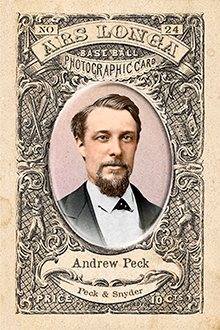
- Series: Pioneer Portraits I: 1850-1874
- City: New York
Andrew Peck (1836-1918) and his partner Walter Irving Snyder founded the first true sporting goods store in 1866 at 124-128 Nassau Street in New York City. The pair wanted to promote their business and thought trade cards might help. In 1869, this was a common technique for many retailers, but Peck and Snyder wanted something distinctive. They came up with the idea of using the image of Harry Wright’s nationally renowned new professional baseball squad, the Cincinnati Red Stockings, as their motif. A few versions were printed, the most prized of which today features the players in uniform and their names below the photo. No one could have known that this modest marketing scheme would pave the way for one of the great products and hobbies in American history, as Peck and Snyder unwittingly established a framework for the mass-produced baseball picture card. Following the Red Stockings release, the company issued cards featuring the hometown Mutuals and rival Chicago White Stockings in 1870. Other manufacturers soon followed suit and baseball cards became an advertising mainstay.
- Peck posted inning-by-inning telegraph reports of the big game between the NY Mutuals and Wright’s club in 1870 to a fevered crowd of NY “cranks.” Final tally: Cincinnati 15, NY 12.
- Peck started his business with ten cents to his name and died a rich man
- Perhaps not rich enough to buy his own trade cards today though: a Peck & Snyder 1869 Cincinnati Red Stockings card recently sold for $75,000

- Series: Pioneer Portraits I: 1850-1874
- City: Baltimore
- Team: Canaries
- League: National Association (NAPBBP)
Lipman Emanuel Pike (1845-1893) has many claims to fame as one of the most prodigious power hitters of early baseball. He was one of the first to be paid to play, he was a perennial field general on some of the best teams of his era, he hit some of the longest home runs in the earliest parks, he was one of the first players blacklisted, he was one of the fastest players of his time. And, if not the first, he was certainly the first Jewish player of note in the game. Pike came up in the infancy of baseball and starred for the great early clubs: The Brooklyn Atlantics, Philadelphia Athletics, NY Mutuals and the Irvington NJ nine. A solid all-around player, the southpaw even held his own at second and short. Movie-idol handsome, Lip always made his team look good. And he made a lot of teams look good. A lifelong itchy foot led Pike to change clubs as often as some players changed spikes. He never lasted more than two seasons with any franchise. In an era when home runs were scarce, Lip was one of the top sluggers. In 1883 Sporting Life documented a remarkable artifact of Pike's power. With the demolition of Brooklyn's old Union Grounds, the writer described the “pagoda” that had stood in right center from which rose an iron rod, bent from a ball struck by Pike and preserved as a cherished icon. Later research indicates Pike's HR slammed that rod 40 feet above the ground and about 360 feet from home plate hard enough to bend iron - in the deadball era.
- Pike, with eight others, was ousted by the NL owners in 1881 for suspicion of throwing games
- Out of the game, Pike returned to his family haberdashery in NY where he perished from heart disease at age 48. His renown persisted for decades, leading to one vote in the first HOF ballot in 1936

- Series: Pioneer Portraits I: 1850-1874
- City: Philadelphia
- Team: Athletics (NABBP)
- League: National Association (NAPBBP)
Alfred James Reach (1840-1928) “served baseball with distinction as player, organizer, club owner and provider of the equipment to attain the highest possible skill in the game” per his own Reach’s Official Base Ball Guide upon his death. “A good man, of the kindest impulses, his name will last as long as we have baseball” expressed the legacy of one of the great men of the early era of America’s game. The London-born, Brooklyn-raised Reach joked that he made the gloves he eschewed in the beginnings of the game in which he starred for the Brooklyn Eckfords and Philadelphia Athletics. He also made the AL’s balls while owning the NL Phillies franchise. A genius for marketing equipment and a lifelong love of the game made him one of the most influential figures of baseball’s first half-century.
- Began play in the amateur era, then founded the NL’s Philadelphia club in 1883
- Built the first modern ballpark in ’87, then rebuilt it with steel after a fire in ‘94
- Al's brother Bob Reach was a MLB shortstop for 3 games, 1872-1873
- Was the 88th player to debut in MLB
- Series: Pioneer Portraits I: 1850-1874
- City: Brooklyn
- Team: Star of Brooklyn
- League: National Association (NABBP)
Fraley W. Rogers (1850-1881) played at the cusp of the professional era, mostly with the Star of Brooklyn in the old Nat’l Assoc of Base Ball Players. Played the ’72 (championship) season for the Boston Red Stockings, compiling a decent .276 average in RF. Sadly, Rogers is the earliest known professional ball player to take his own life, by gunshot at age 30.
- The Star of Brooklyn was a breeding ground for talent in the 1860s
- ’72 marked the end of the “Knickerbocker Era” and the start of professional ball
- Fraley’s brother Mort Rogers was a National Association umpire who innovated the Mort Rogers’ Scorecards that inspired this series of Pioneer Portraits
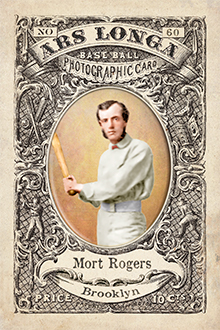
- Series: Pioneer Portraits I: 1850-1874
- City: Brooklyn
- Team: Resolute BBC
- League: National Association (NABBP)
Maxson Mortimer Rogers (1845-1881) had a profound impact on both the national pastime and the innovation of the baseball card. Unfortunately, his unique contributions have been largely lost to memory and obscured by history.
Rogers began his sporting life as a cricketer and, by the mid 1860s, had become a prominent star baseball player and executive for Civil War era teams such as the Resolute BBC of Brooklyn. By 1864, Rogers was secretary of the NABBP, baseball’s first professional league, and was elected the league’s first vice-president in 1867.
As a professional printer and entrepreneur, Rogers self-published a weekly sports paper called the New England Chronicle from 1869-1870, devoting substantial ink to the developing game he loved.
By 1871, Rogers was umpiring NABBP games in Boston while self-printing and selling “Base Ball Photographic Cards” at the games for .10 cents a piece (the price was later dropped to .05 cents). Rogers’ stated ambition was to produce a card for every prominent player in the country, but as so few of his cards exist today it is difficult to know the exact diversity or quantity of cards he was able to produce.
The Mort Rogers’ Scorecards were foldable scorecards with an image of a baseball player on the front pane (including the player’s name, position and team), a scorecard in the center two panes for that day’s game, and a group of advertisements on the rear pane. Rogers produced and sold the cards from 1871-1872.
Although there is still great debate over which card or set of cards should be considered the very first, a solid case can be made to declare Mort Rogers the Father of the Baseball Card. Ars Longa pays homage to Rogers’ legacy with this very Pioneer Portraits I series of art cards.
- A testament to his playing prowess is Mort’s inclusion in an 1865 woodcut in Frank Leslie’s Illustrated Newspaper depicting the “leading players” among NYC clubs (The woodcut includes a black-shrouded Jim Creighton in memoriam and an unidentified non-player thought to be Henry Chadwick)
- Mort’s younger brother Fraley Rogers was an early star in NY and Boston, but had an ill-starred fate as the first pro player to take his own life, at age 30, three days before Mort’s death
- Historian John Thorn, who has done groundbreaking work on contenders for “earliest baseball cards,” honors and cites Rogers’ work as the “first numbered set”
- In Mort’s honor, his Ars Longa card is numbered 60, the last in the set. The complete set will be numbered 1-58 & 60 with number 59 omitted from the series to represent the original Mort Rogers' Scorecards that are likely lost to us.
- Series: Pioneer Portraits I: 1850-1874
- City: Baltimore
- Team: Canaries
- League: National Association (NAPBBP)
John Joseph Ryan (1853-1902) broke into the majors with the Philadelphia White Stockings of the NAPBBP in 1873, their first season in pro ball. The team finished second with a record of 36-17. He played for the cellar-dwelling Baltimore Canaries the following year, the franchise’s last. Ryan went to the New Haven Elm Citys in ’75, their only year in the league. In 1876 Ryan joined the Louisville Grays for their inaugural season. He ended his career in ’77 with Cincinnati. Ryan’s best year was with the Grays in ’76, hitting .253 with his only HR.
- Ryan became a Philly cop and died in the line of duty, while making an arrest in a bar fight
- Series: Pioneer Portraits I: 1850-1874
- City: Boston
- Team: Red Stockings (NAPBBP)
- League: National Association (NAPBBP)
Harry C. Schafer (1846-1935) became, literally, an everyday player at 3B for Boston (the Red Stockings 1871-75 and Red Caps 1876-78.) He played on 5 championship teams, including 4 straight with the Red Stockings. Schafer also played in the amateur NABBP for the Philadelphia Athletics, 1868-1870.
- Played in every Red Stockings’ game for the team’s first four years
- Had a busy rookie year, recording Nat’l Assoc records for 3B put-outs, assists and errors
- The handsome Schafer was nicknamed “Silk Stockings” and compiled a .271 lifetime batting average

- Series: Pioneer Portraits I: 1850-1874
- City: Philadelphia
- Team: Athletics (NABBP)
- League: National Association (NAPBBP)
John Phillips Jenkins Sensenderfer (1847-1903) was a second baseman and outfielder for the Philadelphia Athletics during the first four years of the National Association of Professional Base Ball Players, from 1871-74. The debonair man with an aura of aristocracy earned his nickname at least in part from the elegant mustache he sported. The Count, a lifelong Philadelphian, had been with the club in the amateur league since 1866, making him one of the true leading lights of baseball’s earliest days. Sensenderfer hit .299 over his ML career, but injuries prevented him from approaching the outstanding batting he displayed in the Athletics’ early days in the NABBP. For example, he scored over 200 runs in 1868 as one of the most prolific of early hitters.
- After leaving baseball, Sensenderfer turned to politics. He was a local county commissioner and active in state Democratic roles as well
- Series: Pioneer Portraits I: 1850-1874
- City: Boston
- Team: Red Stockings (NAPBBP)
- League: National Association (NAPBBP)
- Hall: National Baseball Hall of Fame
Albert Goodwill Spalding (1850-1915) was an elite pitcher who retired at age 27 and proceeded to influence the game as few others have. He helped organize the National League, co-founded A.G. Spalding sporting goods, published the game’s first official rules, traveled the world to promote baseball, owned the White Stockings and led an Olympics, leaving one of the great legacies in sport.
- Was a five-time pennant winner with the Boston Red Stockings and Chicago White Stockings
- Career 252-65 record with a .796 winning percentage
- Elected to Hall of Fame: 1939
- Series: Pioneer Portraits I: 1850-1874
- City: Brooklyn
- Team: Atlantics
- League: National Association (NABBP)
Joseph Start’s (1842-1927) baseball career spanned the early days of the game before the Civil War and included two NL titles with the Providence Grays. Start was a premier first baseman beginning with the Enterprise of Brooklyn and the Atlantics (1860-71) and extending to the NA Mutuals (1871-76) and several NL teams, well-earning his nickname, Old Reliable.
- Best year was ’78 with the Chicago White Stockings, leading the league with 100 hits and 125 total bases
- Playing exclusively in the “no-glove” era, his .963 fielding % at first base over 16 seasons is remarkable
- Series: Pioneer Portraits I: 1850-1874
- City: Philadelphia
- Team: Athletics (NABBP)
- League: National Association (NAPBBP)
Ezra Ballou Sutton (1849-1907). A 3rd baseman & shortstop, Sutton played for 5 teams over 20 seasons. Ezra was the 1st player to hit a home run in Major League baseball, and became the 1st player to hit 2 HRs in one game when he hit his second that day (in a losing effort). Sutton was also one of the 1st ball players to collect 1,000 career hits.
- Played in 1st National Association game: 5.4.71
- Played in 1st National League game: 4.22.76
- Lifetime .294 batting average
- Sutton is tied with 17 other players as the first player in major league baseball history

- Series: Pioneer Portraits I: 1850-1874
- City: New York
- Team: Gothams
William Hathaway Van Cott (1821-1908) reminds us that nostalgia never gets old. In 1854 he wrote a letter to the New York Times that became the Gray Lady’s first reference to the game of “Base Ball.” He emphasized that the game his Gothams and friendly rivals the Excelsiors and Knickerbockers were playing was greatly improved from the “old-fashioned game” of yore; “thoroughly systematized” and played more skillfully. By 1858 he had been chosen the first President of the first official league, the NABBP. Future “Father of Baseball,” sportswriter Henry Chadwick’s first exposure to the game he would bring to national fame occurred in July of ‘58, at the renowned “Fashion Course Games” where Brooklyn’s all-stars vied with NYC’s finest. Justice (16 years on the bench) Van Cott scored that game. William’s brother Thomas was the star pitcher of all the NY clubs in the 1850s and pitched the game. The young NY centerfielder was Harry Wright, a cricketer who would go on to invent professional ball.
- The jurist would go on to campaign for the elimination of New York gang influence and paid a hefty price: two attempts were made to burn his home. A founding father and courageous public servant
- Series: Pioneer Portraits I: 1850-1874
- City: New York
- Team: Knickerbockers
William Wheaton (1814-1888) was an early pioneer of the new game of “base ball.” He was an officer in the Knickerbocker Club and served on its rules committee. According to his own account he may have been the first to codify rules of the game, for the Gotham Base Ball Club in 1837.
- Took time from his law practice to play the new game with business associates
- Received a federal appointment from President Grant, 1876-86
- In ‘87 bemoaned the fast pace of life compared to the days he could while away on the diamond
- John Thorn, official historian of MLB, champions Wheaton as the true “father of baseball”
- Series: Pioneer Portraits I: 1850-1874
- City: Boston
- Team: Red Stockings (NAPBBP)
- League: National Association (NAPBBP)
- Hall: National Baseball Hall of Fame
James Laurie “Deacon” White (1847-1939). Considered the greatest catcher of baseball’s barehanded period (1870s), White eventually moved to 3rd base, played 23 seasons, won 6 championships, and played with a number of the century’s best players on a number of the century’s best teams.
- 1st person to bat in 1st pro league, in 1871, earning a hit – a double
- Reportedly believed the earth is flat
- 2 batting titles; 3 RBI titles
- Elected to Hall of Fame: 2013

- Series: Pioneer Portraits I: 1850-1874
- City: Philadelphia
- Team: Pythian B.B.C.
- League: Independent
Jacob C. White Jr. (1837-1902) was the son of a preacher in Philadelphia who grew into one of the city's most prominent businessmen. With his friend Octavius Catto, Jake founded and helped lead the Pythians, one of the first and most successful black baseball clubs of its day in America. Catto was the fiery on-field presence that galvanized the Pythians into a force on the national scene as baseball and the country emerged from the darkness of Civil War. But he depended on his childhood pal to help fund the club and give it necessary administration. White had earlier demonstrated the gifts of organization and leadership Catto needed when he took over the Robert Vaux school in 1864, taking it from a damp church basement struggling to help a few dozen black kids to a noted institution whose legacy continues today. Thanks to White's intellectual bent, the Pythians were as unlike the typical white ball clubs of the time as possible. The Club shared quarters with the Banneker Institute, also founded by White. The Pythians were refined gentlemen representing the elite of black society in Philadelphia. They were as interested in scholarly debate, abolition, desegregation and civil rights as they were in playing ball. Catto and White tried to join the National Association of Base Ball Players and, despite the support of the Athletics, were rejected. Eventually, in 1869 the club did get one chance to play a white team, the Philadelphia City Items, and walloped them 27-17.
- White was the promoter of a distincive feature of black baseball in Philadelphia: an all-day celebration of sport and fellowship which invariably ended with a banquet organized by Jake
- When his best friend and partner Catto was assassinated in the lead-up to the 1870 elections, a grieving White stepped away from the game he loved but continued to serve his city for decades
- Series: Pioneer Portraits I: 1850-1874
- City: Cincinnati
- Team: Red Stockings (NABBP)
- League: National Association (NABBP)
- Hall: National Baseball Hall of Fame
George Wright (1847-1937) was considered baseball’s best player while starring for the Cincinnati Red Stockings, the game’s first professional team. He continued to excel at shortstop and at bat for the team his brother Harry moved to Boston in 1871. He co-founded Wright & Ditson Sporting Goods, contributing to tennis, hockey and golf, and built America’s first public golf course. He also fathered two US tennis champions.
- Wright was a seven-time league champion with Cincinnati, Boston and Providence
- Was a consultant on the foundation of the National Baseball Hall of Fame
- Elected to Hall of Fame: 1937
